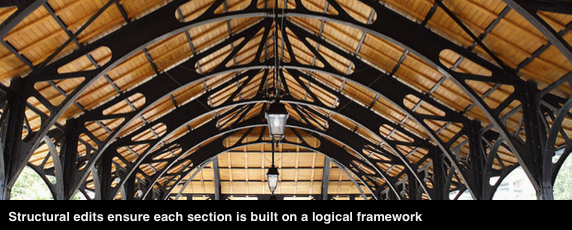This and upcoming posts focus on editing proposal content to keep evaluators reading. The goals are to make efficient use of resources and to avoid last-minute rewrite marathons.
If you haven’t already read the posts on Developing content prompts and Managing early drafts, please do so now. They contain useful background to this post.
Structural editing (also called strategic editing) aims to ensure content responds to the RFP questions—but also that it:
- Is logically organized
- Contains no redundant or non-responsive content
- Addresses the issuer’s strategic requirements and hot button issues
- Positions the offer against known competitive strengths and weaknesses
- Takes advantage of visualization to improve readability and persuasiveness
Before you start
Revisit the RFP requirements, evaluation criteria and scoring system, and the team’s win strategy. Review any content prompts, section outlines, or other direction provided to content developers at kickoff.
Because structural editing requires context and bold changes, the best choice for this job is often the proposal manager or another senior team member.
Structural editing process
Read the entire section without making edits. Structural editing is about adjusting structure, not sentences. If you struggle to resist copyediting while reading, try sitting on your hands. (Seriously—it works!)
Evaluate each response for structural logic and completeness. For example, if the RFP requires:
- A yes/no or numerical answer, make this the first sentence of the response, followed by additional information, if needed.
- A plan or approach, compare the response against the prompts or approved section outline or bullet point analysis. Restructure the response as needed. If no prompts were provided, improve the logical flow of the response as necessary.
- Similar long-form responses (e.g. “Describe the team’s experience in . . “) in multiple sections, align the structure of all the corresponding responses, to the extent possible.
Identify the following and take the actions indicated:
- Gaps. Solution: Highlight and comment, referring to RFP ask
- Non-responsive and/or non-compliant content. Solution: Highlight and add comment.
- Redundant content. Solution: Merge or cut.
- Empty content, platitudes. Solution: Delete.
Look for opportunities to:
- Convert plain text to tables or lists. Solution: Convert as appropriate. Consider using bulleted lists instead of text strings of five or more items. Use tables to show relationships, such as pros and cons, events and consequences (e.g. a risk management matrix), chronology, etc.
- Visualize key ideas. Solution: Convert plain text to graphics to highlight important benefits and advantages. If your team is new to using visualization, Complex2Clear’s proposal blog index links to several posts. See column “V”.
Make clear, constructive comments. Structural editing usually exposes gaps and creates other work for the content drafter, who may not have your strategic perspective. If you’ve made dramatic changes to the draft, call or meet with the writer to walk through your reasoning and next steps.
The payoff
Strong structural edits transform proposals. This step unifies multi-author responses, giving evaluators the sense that the proponent team is cohesive and well-organized, with a clarity of purpose and approach. Well-structured proposals are also easier to read and score.


